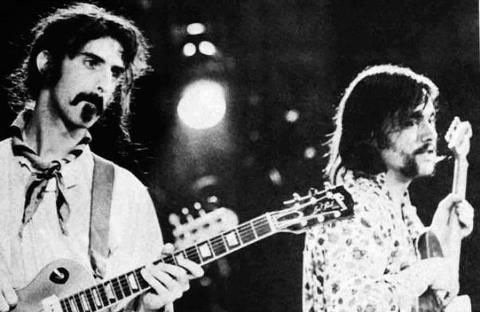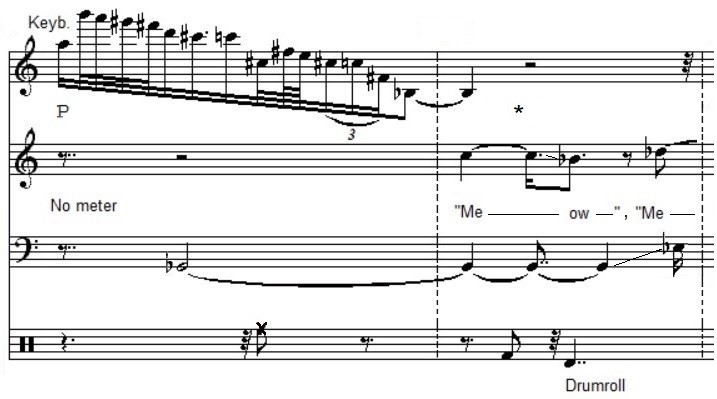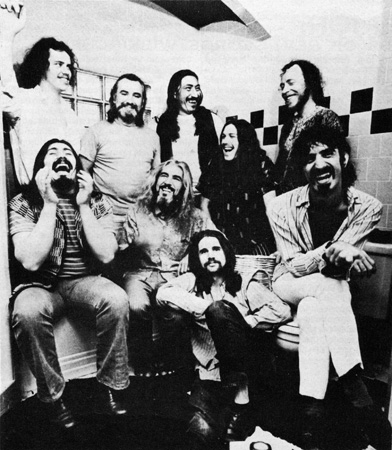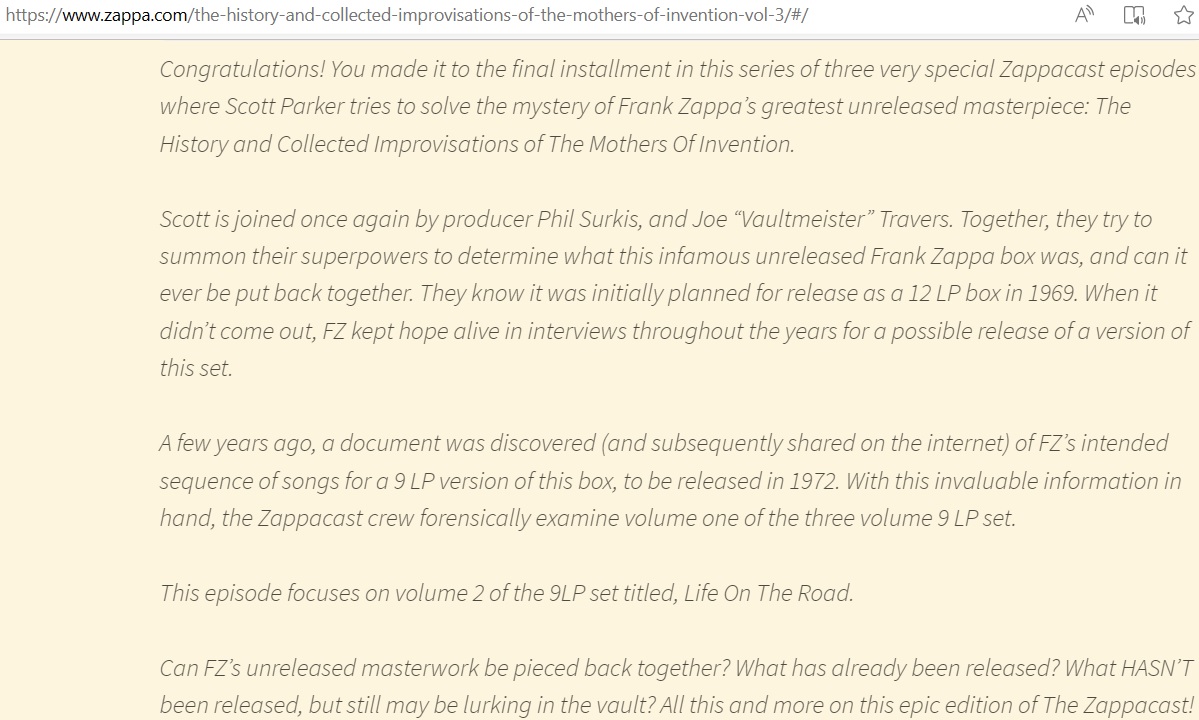YCDTOSA VOL. V, DISC I: IMPROVISATIONS (CNTD)
This section is a continuation upon the previous one with material from "YCDTOSA Vol. V". The whole of disc I of this CD is devoted to the original Mothers of invention, as they played live at the end of the sixties. Regarding content it fits very well into the idea of the "collected history and improvisations of The Mothers of Invention". There are story-telling pieces in it and a lot of improvisations. The "YCDTOSA" series in its total has a section of its own in this study, with examples from each of the six CDs involved.
Baked-bean boogie
"Baked-bean boogie" from vol. V is Zappa himself soloing. It's a solo in Eb Dorian
over a bass riff. It turns out to be an outtake from the "Uncle Rhebus" track, that the ZFT included in their "Finer moments" release from 2012.
Baked-bean boogie, opening (midi file).
Baked-bean boogie, opening (transcription)
See the Uncle meat section for a description and examples from "Uncle Rhebus".
In the YCDTOSA section at Vol. V you can find links to a few more examples from this CD,
with three that are part of disc II. Vol. V is divided into two unrelated CDs with one covering the years 1965-9 and the other covering a 1982 concert.
Disc I includes that many previously unreleased titles, that its merits require a section of its own in this study for completing the picture
of what the Mothers were doing during the late sixties, additional to the previous sections.
No waiting for the peanuts to dissolve
"No waiting for the peanuts to dissolve" is another instrumental with subsequently Lowell George, Zappa and Bunk Gardner soloing.
The section with Zappa on lead guitar is the best example of pentatonic music, that I've encountered so far. Zappa's music can frequently
contain pentatonic passages, but here you can hear the pentatonic scale being used over a longer period by the whole band.
Upon the tonic this set is E-G-A-B-D. At some points you can also hear an A#, C and C#, but these are more chromatic passing notes.
No waiting for the peanuts to dissolve, section (midi file).
No waiting for the peanuts to dissolve, section (transcription)
Staff one from the example is Zappa, staff two is Lowell George. Pentatonic episodes are in case of Zappa always embedded
in diatonic environments or being played next to other scales. In this case the piece as a whole is in E Dorian, which is why I've also notated
this section as if in E Dorian. The F# from this scale isn't touched upon at all in this example.
Chocolate Halvah
 In "Chocolate Halvah" Zappa is responsible for creating an environment with some fixed elements while others can improvise. In this
case this environment is formed by the drums/guiro - bass - rhythm guitar combination as represented in staves 4-5 and the two percussion lines
of the example, bars 1-3. It's some sort of vamping figure with the percussion standing central. The bass and rhythm guitar vary a little.
Roy Estrada is "swami #1", singing the notes of staff one. Lowell George sings staff two as "swami #2". Both
get co-credited for their contribution. To the right: Zappa and Lowell George.
In "Chocolate Halvah" Zappa is responsible for creating an environment with some fixed elements while others can improvise. In this
case this environment is formed by the drums/guiro - bass - rhythm guitar combination as represented in staves 4-5 and the two percussion lines
of the example, bars 1-3. It's some sort of vamping figure with the percussion standing central. The bass and rhythm guitar vary a little.
Roy Estrada is "swami #1", singing the notes of staff one. Lowell George sings staff two as "swami #2". Both
get co-credited for their contribution. To the right: Zappa and Lowell George.
Chocolate Halvah, 2:39 till 3:05 (midi file).
Chocolate Halvah, 2:39 till 3:05 (transcription)
There's a bass pedal and a bass E-D-E figure during most of this song, while the "rhythm guitar" from staff 4 scratches notes from E Dorian. Apparently both staves
3 and 4 are played by Zappa. Lowell George gets credited for playing guiro, a Latin percussion instrument, that creates rattle-like sounds.
Because of the chromatic notes of the sung part, however, the atmosphere gets between diatonic and atonal. Towards the end
regular guitar chords enter the picture. These chords set the character of piece firmly towards diatonic playing in E Dorian. In bars 3-8 it's
two times I-IV-III. When these chords are coming in, the characteristic drum beats of bars 1-3 are left to make place for standard 4/4 drumming.
Underground freak-out music (Black beauty)
"Underground freak-out music" is another example, where Zappa is responsible for setting up the outlines of a song, while
Lowell George and Don Preston are the soloists in it. He introduces this piece as "This is underground psychedelic acid rock freak-out music".
Both the guitar and keyboard/electronics parts are using fuzz tones. At some points I'm not even sure who's doing what. The bass
part is a rapidly pulsing Eb pedal note, something the later hard rock fans became to crave for.
Underground freak-out music, 0:05-0:26 (midi file).
Underground freak-out music, 0:05-0:26 (transcription)
The song starts off as pentatonic. The example above, with the first eight bars, is entirely pentatonic except for a D natural passing note.
It takes a while before the other two diatonic notes introduce themselves. A C appears in the guitar part at 0:47 minutes and as an Ab-C chord
by the saxes at 1:14. From 1:28 onwards the song becomes regular Eb Dorian with the total scale being involved, including the F.
"Black beauty" from "The mystery disc" is a different edit of this track.
You call that music?
"You call that music?" is an experimental example from 1969, released on "YCDTOSA vol. IV". It begins with improvising over a low electronic bass pedal, sort
of a drone coming up and disappearing again several times.
You call that music?, 2:45-3:23 (midi file)
You call that music?, 2:45-3:23 (transcription)
The example above is a block in 4/4 with a chord per bar, of which the notes keep changing with mostly minor second leaps. Most of the time you can hear a very
high sustained G note lightly in the background. All instruments are playing gently with low volumes. Only staves 5-6 from bars 9-13 have some more volume.
It sounds peculiar, a bit mysterious, and it's also hard to hear the exact notes involved.
Alley cat
"The lost episodes" CD from 1995 contains "Alley cat", an improvisation over a bass lick, credited to Don van Vliet and Zappa. It was recorded in 1969 during the production of Van Vliet's "Trout mask replica"
album. Elliot Ingber gets credited for playing slide guitar. Strangely enough, nobody gets mentioned who might be playing bass. It was recorded in the basement
of Zappa's house with a Scully 2-track.
Alley cat, 0:17-0:33 (midi file)
Alley cat, 0:17-0:33 (transcription)
It's a jam in E Dorian, following a 4/4 meter. While musical elements are getting repeated, Don van Vliet (Captain Beefheart) improvised the lyrics on the spot.
At various points former members from the Mothers of Invention participated in Beefheart's Magic band. Elliot Ingber
had played as a Mother on "Freak out!" in 1966, now nicknamed as Winged Eel Fingerling in the Magic band.
Proto-minimalism
The term "minimal music" got first used in the late sixties for referring to music that is deliberately using a limited number of musical parameters, music
that is repeating figures over and over, letting them change little by little over time. As a style it had it haydays in the seventies.
This track does have characteristics that you could call minimalistic, most specifically staff one, that is using a C only throughout most of this piece.
Less typical are the changes of the meters and rhythms, that don't change gradually, but frequently.
Proto-minimalism, 0:18-0:24 (midi file)
Proto-minimalism, 0:18-0:24 (transcription)
Zappa's "Proto-minimalism" is an experimental live recording from 1969. Very likely this is a composition of which he set up the outlines, whereas band members
could fill in and improvise the details on the spot. In the "YCTDOSA vol. V" booklet, the band gets credited for playing their standard instruments. As I'm hearing
it two people are playing vibes in the example above, while two others are playing percussion. So it can't be Art Tripp and Jimmy Carl Black alone,
others must have participated as well. Staff four represents woodblocks, having pitches.
Staff five a drumset, notated in a reduced form (bottom up: bass drum, ticks (various forms) and cymbals (idem)).
At the Kill ugly radio site a transcript of a 1988 interview with Bob Marshall can be found, indicating Zappa had no
high opinion of minimal music (https://wiki.killuglyradio.com/wiki/Interview_by_Bob_Marshall):
"I'm not enthusiastic about minimal music because I think that it's like the one-joke composition.
You take any composition and repeat a single element for a small eternity and the joke is over.
Are you going to build a career out of repeating small elements over and over and over again.
The subtext to minimalism is that it's cheap to produce.
It's Taco Bell music. It's cheap to rehearse, cheap to mount, and because it doesn't really offer any great intellectual challenge other than the stamina
of the listener to tolerate an infinite number of repeats of a small thing, what's the message?
This is a musical question which I feel is easily answered and has been answered amply many times,
and so it is not a musical question that I am particularly curious about, myself."
Meow
Zappa frequently had acoustic instruments amplified and electronically mutated, as explained in the "Uncle Meat" booklet.
One of the side-effects is that two subsequent notes could sometimes sound a bit like "meow".
"Meow" is an experimental track including the brass section letting some of their notes sound as "meow" (staff two below), starting half-way the song.
Human voices saying "meow" can be heard as well.

The song knows a repeated pattern. First the keyboard plays a fast string of notes with open pedal, next the other band members join in using
a limited number of notes. In the example above it's the bass with a sustained note ending with a little upwards glissando, plus drums.
This fragment is played between 0:51 and 0:54. This piece is not really fit for transcribing or creating a midi file from it. It's atonal, has no meter
and the example is by approximation.

The Mothers in 1969, photo downloaded from the net, photographer unknown.
FZ/JCB drum duet
During the "FZ/JCB drum duet" Jimmy Carl Black plays regular drums, credited as "rhythm drums", while Zappa and next
Art Tripp are playing a percussion solo. Jimmy Carl Black is playing the steady beat, that I've notated in 4/8, while the solo parts
are freely improvising. During "The clap" from the 1970 "Chunga's revenge" album Zappa plays both these parts by overdubbing.
The example below is to a point an approximation. The variation in volume, percussion sounds and
ticks involved is richer than what I put on paper.
FZ/JCB drum duet, 0:00-0:08 (midi file)
FZ/JCB drum duet, 0:00-0:08 (transcription)
There's a split second of squeaking noise that begins this piece, that probably comes from editing. Very likely this
title directly followed upon a preceding song with the bass in staff two playing the final notes, that also serve
as a pick-up bar for this piece. The two dissonant keyboard chords are also coming over from the previous song.
Where's our equipment?
"Where's our equipment?" is one of the rare official live recordings from the year 1967. In fact, the best entrance for live
material from this year is the "'Tis the season to be jelly" bootleg from the "Beat the boots" series, that you might call semi-official material.
This title deals with the band doing a concert in Copenhagen while much of their equipment was still on its way in a truck that got delayed in a snow storm.
So they played with equipment they managed to borrow. The recording itself was done by a journalist following the band.
Where's our equipment?, 2:04-2:13 (midi file)
Where's our equipment?, 2:04-2:13 (transcription)
There were three saxophone players in the band at that time. With Ian Underwood playing the highest tuned alto sax, this example very likely is him
improvising, while Zappa is conducting the rhythm section. You can compare it with the "Ian Underwood whips it out" track from "Uncle Meat", a take-out
from the same concert, where he's also squeezing out very high notes from his saxophone.
Tiny sick tears
In Neil Slaven's biography Valerie Wilmer gets quoted for describing how The Mothers could open one of their shows at The Garrick Theater in 1967,
namely by beginning with a medley of "My boyfriend's back", "Hanky panky" and "96 Tears". The last song was a hitsingle by ? and the Mysterians and
it is this song "Tiny sick tears" is parodying. It's from 1969, recorded at The Factory in The Bronx, released on "YCDTOSA Vol. IV".
It has Zappa telling a little story over a repeated chord progression. Regarding the text it ends with an allusion to
the song "The end" by The Doors. It deals with a teenage guy, who, because of his problems, can't fall asleep and goes to the kitchen to eat some cookies.
On his way back he passes his syblings doors and next his father's. When entering his father's room he says "Father, I want to kill you". Other than in The Door's song
he catches his father wanking, with his father answering "not now, son".
Tiny sick tears, 3:30-3:48 (midi file)
Tiny sick tears, 3:30-3:48 (transcription)
At the end of the story, some Mothers routines turn up as shown in the example from above:
"Bar" 1: end of everybody improvising ad lib. for a little while.
"Bar" 2: one person saying "Hands up" at a hand signal.
"Bar" 3: the band saying "Poo-wah" at another hand signal.
Bars 4-7: the chord progression returns with Zappa commenting.
This two-chord progression is a parallel playing of two dominant 7th chords, C7 and F7. C7 in C Mixolydian could resolve to F, but with adding a minor 7th to the last
chord again, the progression becomes sort of a perpetuum mobile of non-resolving 7th chords. In the example above Zappa calls it soul music.
His comments continue with: "for one thing it's really easy and for another thing waists a lot of time while we're on stage. We learned in our travels
that teenagers are ready to accept these chords, no matter how they're played ... it makes you feel secure because after dit-di-dit-di-dit-dit you know
the other one is going to come on, and will never fail. Simple. Some people would say it's bullshit, but we love it, don't we kids?"
In 2024 the ZFT released "Whisky a go go, 1968" with The Mothers improvising over this chord alternation during the
"Tiny sick tears jam". On that occassion it's largely an instrumental. The chords
imply C and F Mixolydian, while Zappa is to a larger degree following C Dorian/minor pentatonic.
Are you upset?
Also to be found on "YCDTOSA Vol. IV" is "Are you upset?", a little collage of Mothers routines. It starts with the 5/8 figure as described in the previous section
at "Prelude to the afternoon of a sexually aroused gas mask". Next you've got the brass section playing improvised notes with an intonation that Zappa describes in
"Toad of the short forest" as blowing their noses, along with a human voice saying "wehhh".
Are you upset?, 0:27-0:46 (midi file)
Are you upset?, 0:27-0:46 (transcription)
Upon this the example from above is following. First the rhythm section is playing five bars in standard 4/4 with the brass section playing a few notes in the background.
Next, in bar 6, the blowing their noses routine restarts more heavily (the midi file can't represent this effect properly). A guy back in the audience is shouting that loud that he reaches the stage as well as the recording mikes,
screaming "stop it" or "fuck you" a couple of times. Zappa notices this and reacts with asking "Are you upset?". The guy screams something like fuck you once again, with
Zappa responding with "I'm fucked? That's the nicest thing anybody said to me all day". The other people from the audience seem to find it amusing.
Other tracks from YCDTOSA Vol. V, disc I
- "The downtown talent scout" is included in the Freak out! section of this study.
- "Charles Ives": its main riff is also present during "Didya get any onya?" from "Weasels ripped my flesh".
See the corresponding section for both titles.
- "Piano/drum duet": see the "Ahead of their time" section for this title being played life in 1968
as part of "Like it or not".
- "Run home slow", "The little march" and "Right there": these titles contain material stemming from the Run home slow film.
See the corresponding "Run home, slow" section from this study.
- "Return of the hunch-back duke": the title for the central themes from "Little house I used to live in",
when played without the intro. See the Burnt weeny sandwich section.
- "Trouble every day" exists in a couple of variants being slightly different. See the Freak out! section for the 1966 rendition.
- The studio version of "My guitar wants to kill your mama"
is present in the Weasels ripped my flesh section.
The collected history and improvisations of The Mothers of Invention
The chances that the original "The collected history and improvisations of The Mothers of Invention" set will ever be released have become about nil.
The actual releases of material with the original Mothers from 1970 onwards would be differently. First two 1970 albums from the set were released individually.
During the nineties Zappa released two live CDs, entirely made up of material with the original Mothers of invention: the already mentioned "YCDTOSA Vol. V", disc 1, and "Ahead of their time".
With the ZFT releases, the total amount is still augmenting:
- FZ albums that were part of "The collected history...":
1) Burnt weeny sandwich
2) Weasels ripped my flesh
- Other FZ albums:
3) Ahead of their time
4) YCDTOSA I: 3 tracks
5) YCDTOSA IV: 3 tracks
6) YCDTOSA V: disc I
7) The lost episodes: tracks 1-22
8) The mystery disc
- Single collections:
9) Rare meat/Cucamonga years/Cucamonga
- ZFT releases:
10) Joe's domage
11) Joe's Xmasage
12) MOFO
13) Lumpy Money
14) Greasy love songs
15) Road tapes, venue #1
16) Finer moments
17) Meat light
18) The Hot rats sessions, CD 3
19) Whisky a go go (1968)
- Bootlegs from the Beat the boots series:
20) 'Tis the season to be jelly
21) Our man in Nirvana
22) Electric aunt Jemima
23) At the Ark
It's impossible to say what would be on the remainder of ten records. But what you can say is that the amount in minutes on
official releases by now (i.e. since 2012, after two more double CDs by the ZFT) has become bigger than what would be on the 12-record set. And when you include the four bootlegs it by far
exceeds the quantity of the "Collected history...". The sound quality of the bootlegs varies between poor and listenable,
but for sixties bootlegs they are surprisingly well. "Electric aunt Jemima" is close to a normal sound quality. "The Ark" is a concert that Zappa
himself recorded as well for a possible album release. These bootlegs give an opportunity to listen to an arbitrary Mothers concert
from the sixties as they used to be. They were full of improvisations and extensive soloing.
I guess you could say that the "Collected history..." mostly has become available, though in a different form. In December
2010 Gail Zappa gave the final verdict upon the status of
the 12-record set (http://www.zappa.com/gzsez/questions/questions/): "Thoroughly dissected and resectioned and
much of it resequenced and recollected into other existing releases. Hard to know today exactly what the original material
consisted of."

Nevertheless attempts to reconstruct the set continue. The screenshot from above comes from the zappa.com site, Zappacast page, item #61, as of July 2023.
